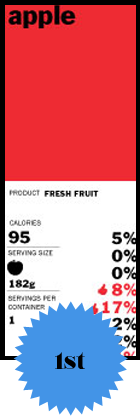Never again will American grocery shoppers need to take up aisles trying to read a food label only a dietician can understand.
A New York Times article reports that the University of California at Berkeley School of Journalism project aims to redesign the confusing nutrition labels on food packages. Several competitors entered their ideas for an improved and easy-to-understand nutrition label. The project entries are not part of the Food and Drug Administration’s official effort to change the nutrition label, but their ideas will most likely be heavily considered.
“There are a lot of things right with the current label, but at the same time people are confused. The question is whether a new nutrition facts label could help people make more educated decisions,’’ Lily Mihalik, co-creator of the project, said in the article.
The winning entry came from Renee Walker, a San Francisco visual designer, who used color-coordinated bar graphs that depict the proportion of ingredients in the food product. The simple design and visual appeal could make food labels easy to understand at all levels.
In second place was Joey Brunelle who decided to put total calories per package or bottle instead of serving sizes. Brunelle also used a system of green/yellow/red stoplight iconography to symbolize whether a food was reasonable, questionable, or unhealthy in its ingredients.
Other ideas used green text or bold print to highlight natural foods and food additives, respectively. An idea from Dylan Brown, creative director for Pixar Canada, was that food content gets graded on a letter scale.
“I like the minimalist approach,’’ said Mr. Jacobson. “Clear lettering, clear grades with added color-coding, and no fancy, space-taking graphs for people to puzzle over. If anything, this label could convey somewhat more information, such as serving sizes. Too bad the food industry would never allow ‘F’ ratings to go on their labels,” Michael Jacobson, a consumer health activist and judge in the contest, said in the article.
The designs are now online available for the public to view at the project’s website Rethink the Food Label. Visitors can see the judges’ choices as well as all of the submitted ideas.
Also Read:

